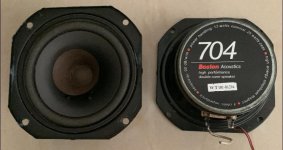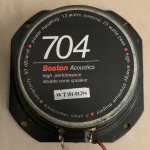The latest post I asked about which amplifier to be used between Pioneer head unit and Soundstream Reference 405. And all people answered the Soundstream. However, I didn’t tell anyone about the speakers to be used. Now I’m going to provide information about them. The speakers are 4” full-range Boston Acoustics 704. I think they’re a bit delicate because they are labeled nominal power at 12W and peak power at 25W. While the Pioneer head unit’s output is rated at 22W (@ 4 Ohms) and the Soundstream Reference 405 is rated at 40W (@ 4 Ohms). So, will the Boston blown if they are paired with the SS405 amplifier? I concern about this because I used to blown my Blaupunkt tweeters when they were driven by the Pioneer head unit, unfortunately, they are OEM speakers in my BMW and have lower rated power than the 22W of the Pioneer head unit.
Attachments
Amplifiers have volume control so max power output not always on.
Tweeters can blow easily with any amplifier.
If over powered. Or the under power myth only applies because
the amplifier can be driven to clipping. Which tweeters do not like.
Followed with common sense to reduce volume if speaker or amplifier distortion
is heard.
If the tweeters just died with no audible distortion, then the heat rating, thermal rating
or power rating etc etc wasn't very good to begin with.
Otherwise long as you dont blast the speakers into distortion. Higher power amplifier is none issue.
Or basically tells me theoretically the amplifier has more current available.
Since the car audio industry seems to be fascinated with horrible 4 ohm or 2 ohm loads.
Better to have more current on tap for more difficult loads such as typically 4 ohms loads
for door speakers.
Tweeters can blow easily with any amplifier.
If over powered. Or the under power myth only applies because
the amplifier can be driven to clipping. Which tweeters do not like.
Followed with common sense to reduce volume if speaker or amplifier distortion
is heard.
If the tweeters just died with no audible distortion, then the heat rating, thermal rating
or power rating etc etc wasn't very good to begin with.
Otherwise long as you dont blast the speakers into distortion. Higher power amplifier is none issue.
Or basically tells me theoretically the amplifier has more current available.
Since the car audio industry seems to be fascinated with horrible 4 ohm or 2 ohm loads.
Better to have more current on tap for more difficult loads such as typically 4 ohms loads
for door speakers.
Last edited:
Speaker ratings are notoriously unreliable. The terms nominal and peak are vague, at best.
As was stated, the volume determines the power sent to a speaker.
A user with self control and an understanding of the power being driven to the speaker could drive a 1w speaker with a million-watt amplifier and never damage the speaker.
I think I mentioned this in one of your previous threads but... you need an oscilloscope to determine the power levels being sent to the speaker. There are battery-powered scopes that are perfectly suited for watching the output level from an amplifier for $30-$40. They're useless for most anything else but perfectly suitable for monitoring audio.
The crossover point will make a huge difference in the maximum output level from a speaker.
What output level are you expecting from these speakers? For just over normal speech levels, this will be fine. If you're listen to enthusiastically listening to metal, techno, trance at high levels, this isn't likely to last long.
What's guiding your selection of speakers?
As was stated, the volume determines the power sent to a speaker.
A user with self control and an understanding of the power being driven to the speaker could drive a 1w speaker with a million-watt amplifier and never damage the speaker.
I think I mentioned this in one of your previous threads but... you need an oscilloscope to determine the power levels being sent to the speaker. There are battery-powered scopes that are perfectly suited for watching the output level from an amplifier for $30-$40. They're useless for most anything else but perfectly suitable for monitoring audio.
The crossover point will make a huge difference in the maximum output level from a speaker.
What output level are you expecting from these speakers? For just over normal speech levels, this will be fine. If you're listen to enthusiastically listening to metal, techno, trance at high levels, this isn't likely to last long.
What's guiding your selection of speakers?
If you blew your factory tweeter, you enabeled loudness and turned up the high frequency. A common problem with people that want to listen louder than their gear can do. Try to get your hearing adjusted to the hardware, not the other way round.
And let's always remember that the HU output power is the most distorted on the market.
With this it is easy to kill tweeters.
As usual, most of the information on car audio that is found around is wrong or subject to marketing.
Whatever power you have, keep distortion away.
Your Bostons are interesting speakers, save them.
If the manufacturer's data indicate a low supported power, perhaps it is also the type of driver that wants it.
These Bostons are full range, so they are called to reproduce all frequencies, it seems understandable to me that with these assumptions the supported power is not high.
I have already worked with this type of speakers, they are good full range, discrete mid-bass and very good mids.
So, if we set a bandwidth for example 500-5000 Hz, we can put these speakers in the best electrical and mechanical conditions, and the supported power will be much higher.
And i agree with all the previous comments.
With this it is easy to kill tweeters.
As usual, most of the information on car audio that is found around is wrong or subject to marketing.
Whatever power you have, keep distortion away.
Your Bostons are interesting speakers, save them.
If the manufacturer's data indicate a low supported power, perhaps it is also the type of driver that wants it.
These Bostons are full range, so they are called to reproduce all frequencies, it seems understandable to me that with these assumptions the supported power is not high.
I have already worked with this type of speakers, they are good full range, discrete mid-bass and very good mids.
So, if we set a bandwidth for example 500-5000 Hz, we can put these speakers in the best electrical and mechanical conditions, and the supported power will be much higher.
And i agree with all the previous comments.

